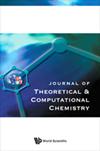Computational design of an intramolecular frustrated lewis pair catalyst for enantioselective hydrogenation
IF 2.4
Q3 Computer Science
Journal of Theoretical & Computational Chemistry
Pub Date : 2020-03-01
DOI:10.1142/s0219633620500091
引用次数: 0
Abstract
We report DFT calculations on potential intramolecular, enantioselective hydrogenation catalysts based around borenium-carbenes based on a camphor scaffold. Using the M06-2X meta-hybrid functional, we find frustrated Lewis pair (FLP) behavior with suitably chosen linkers that prevent association of Lewis bases with the borenium center. These intramolecular FLPs are predicted to be able to heterolytically dissociate H2. Barriers to dissociation and the endo/exoergic nature of the reaction can be tuned by the nature of the base and substituent on B. The reactivity of the hydrogenated FLP catalyst with olefin and carbonyl substrates is then explored: we predict concerted reactions for all substrates considered with relatively low barriers and large exoergic character. Hydrogenation of both faces of a prochiral substrate is also examined, indicating a small but significant variation in reaction barrier in favor of the Si-face, ascribed to stronger interactions with the aromatic [Formula: see text]-system in the TS compared to the Re-face.分子内挫败lewis对映选择性加氢催化剂的计算设计
我们报道了基于樟脑支架的硼卡宾的潜在分子内对映选择性氢化催化剂的DFT计算。使用M06-2X元杂化泛函,我们发现了具有适当选择的连接体的挫败路易斯对(FLP)行为,该行为阻止了路易斯碱基与硼中心的结合。预测这些分子内FLP能够异源离解H2。解离障碍和反应的内/外能性质可以通过B上的碱和取代基的性质来调节。然后探索氢化FLP催化剂与烯烃和羰基底物的反应性:我们预测了所有被认为具有相对低的障碍和大的外能性质的底物的协同反应。还检查了前手性基底两面的加氢,表明与Re面相比,TS中与芳香族[式:见正文]-体系的相互作用更强,反应势垒发生了有利于Si面的微小但显著的变化。
本文章由计算机程序翻译,如有差异,请以英文原文为准。
求助全文
约1分钟内获得全文
求助全文
来源期刊
CiteScore
1.70
自引率
0.00%
发文量
0
审稿时长
3 months
期刊介绍:
The Journal of Theoretical and Computational Chemistry (JTCC) is an international interdisciplinary journal aimed at providing comprehensive coverage on the latest developments and applications of research in the ever-expanding field of theoretical and computational chemistry.
JTCC publishes regular articles and reviews on new methodology, software, web server and database developments. The applications of existing theoretical and computational methods which produce significant new insights into important problems are also welcomed. Papers reporting joint computational and experimental investigations are encouraged. The journal will not consider manuscripts reporting straightforward calculations of the properties of molecules with existing software packages without addressing a significant scientific problem.
Areas covered by the journal include molecular dynamics, computer-aided molecular design, modeling effects of mutation on stability and dynamics of macromolecules, quantum mechanics, statistical mechanics and other related topics.

 求助内容:
求助内容: 应助结果提醒方式:
应助结果提醒方式:


